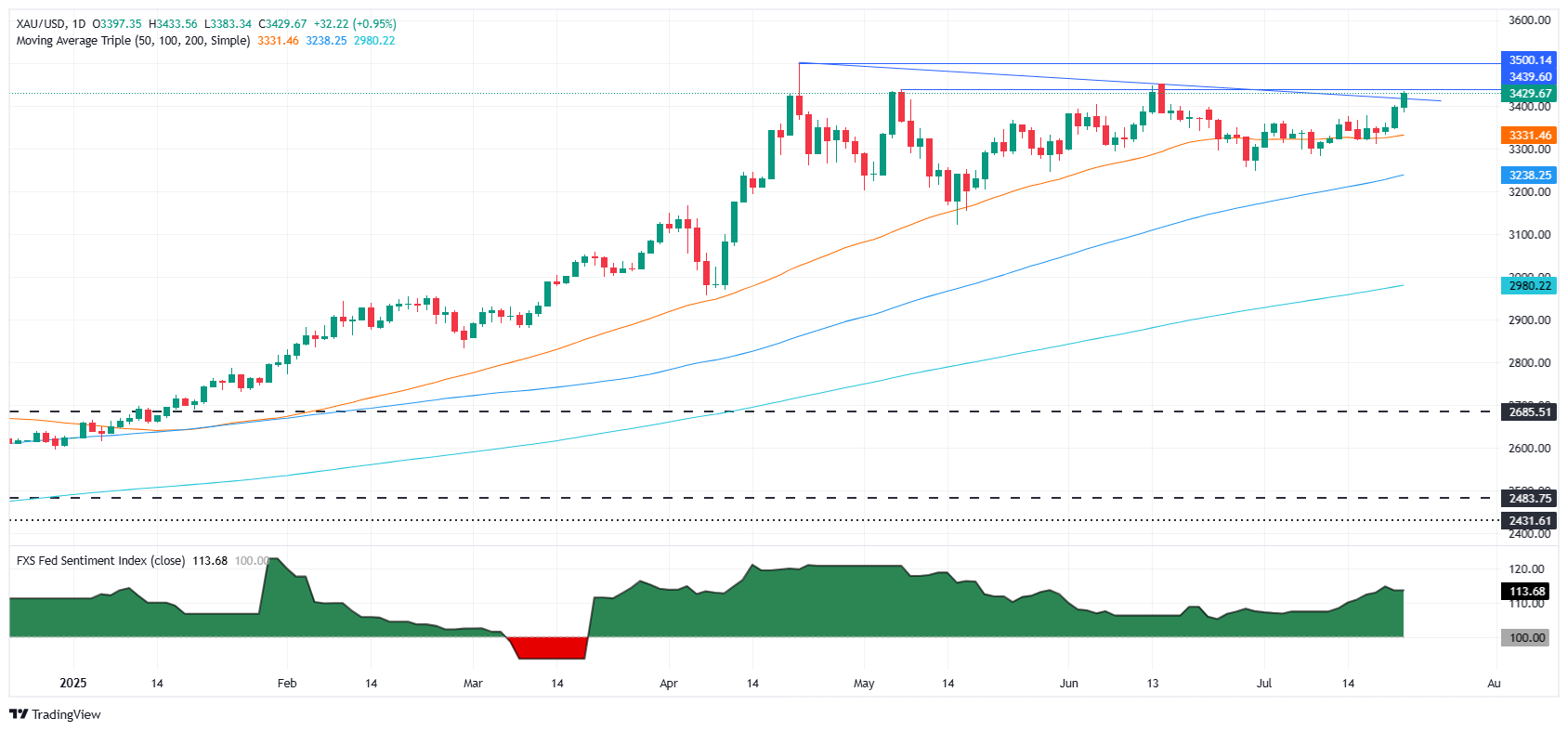Gold surges to 5-week high as US yields slide, trade uncertainty boosts safe-haven demand
- Gold extends rally as US yields fall for fifth day, weakening the US Dollar.
- EU–US trade deal uncertainty and looming deadlines drive safe-haven inflows.
- Trump strikes tariff-exempt deal with Philippines; more announcements expected soon.
Gold price extended its rally to two consecutive days on Tuesday, rising by over 0.9% as US Treasury yields continued their decline, weakening the US Dollar as traders await fresh news regarding new trade deals from the United States. At the time of writing, the XAU/USD trades at $3,427 after bouncing off daily lows of $3,383.
US Treasury yields have dropped for the fifth consecutive session, dragging the Greenback lower, as depicted by the US Dollar Index (DXY). Uncertainty about trade deals and rumors that the European Union (EU) and the US would not reach an agreement before the August 1 deadline augmented demand for safe havens; hence, Bullion prices hit a five-week high at $3,433.
US Treasury Secretary Scott Bessent stated that he will meet his Chinese counterpart next week, hinting at a possible extension of an August 12 deadline. Furthermore, he added that the US is set to announce trade deals with other countries.
Recently, the US President Donald Trump announced a trade deal with the Philippines, which would exempt US imports from tariffs, while the Philippines will pay 19% duties.
This week, the US economic docket remains scarce with the release of housing data, Jobless Claims for the week ending July 19, and Durable Goods Orders data.
Daily digest market movers: Gold price surges as EU-US trade talks seem to falter
- US Treasury yields continued to drop as the 10-year Treasury note dives over five basis points (bps) to 4.332% at the time of writing. Consequently, US real yields, which are calculated by subtracting inflation expectations from the nominal interest rate, have also decreased by four and a half basis points to 1.932%.
- The US Dollar Index (DXY), which tracks the buck’s performance against a basket of six currencies, is down 0.44% at 97.43.
- Trade talks between the EU and the US appear to have stalled, following the White House's imposition of 30% tariffs on EU goods. Consequently, the EU is preparing a retaliatory package in the event that a deal is not reached before the August 1 deadline.
- Last week’s US economic data delivered a mixed picture. While consumer sentiment improved, inflation accelerated in June, with the Consumer Price Index (CPI) nearing the 3% mark. The Producer Price Index (PPI) showed some signs of easing, but a robust Retail Sales report highlighted the continued resilience of American consumers despite the ongoing rise in prices.
- Interest rate probability indicates that the Federal Reserve will maintain its current rates, with odds standing at 94% for a hold and 6% for a 25-basis-point rate cut at the July 30 meeting.
XAU/USD technical outlook: Gold price poised to challenge $3,450 soon
Gold price uptrend appears to resume as the precious metal clears the latest resistance trendline drawn from May and June highs, which passes around $3,420, opening the door for further upside and challenging the June 16 high of $3,452.
The Relative Strength Index (RSI) indicates that buyers are gaining momentum. Hence, Gold could be re-testing record highs in the near term.
Once XAU/USD climbs past $3,452, expect an assault on $3,500. Conversely, if the XAU/USD drops below $3,400, the first support level would be $3,350, followed by the 20- and 50-day Simple Moving Averages (SMAs) at $3,337 and $3,326, respectively, ahead of $3,300.

Gold FAQs
Gold has played a key role in human’s history as it has been widely used as a store of value and medium of exchange. Currently, apart from its shine and usage for jewelry, the precious metal is widely seen as a safe-haven asset, meaning that it is considered a good investment during turbulent times. Gold is also widely seen as a hedge against inflation and against depreciating currencies as it doesn’t rely on any specific issuer or government.
Central banks are the biggest Gold holders. In their aim to support their currencies in turbulent times, central banks tend to diversify their reserves and buy Gold to improve the perceived strength of the economy and the currency. High Gold reserves can be a source of trust for a country’s solvency. Central banks added 1,136 tonnes of Gold worth around $70 billion to their reserves in 2022, according to data from the World Gold Council. This is the highest yearly purchase since records began. Central banks from emerging economies such as China, India and Turkey are quickly increasing their Gold reserves.
Gold has an inverse correlation with the US Dollar and US Treasuries, which are both major reserve and safe-haven assets. When the Dollar depreciates, Gold tends to rise, enabling investors and central banks to diversify their assets in turbulent times. Gold is also inversely correlated with risk assets. A rally in the stock market tends to weaken Gold price, while sell-offs in riskier markets tend to favor the precious metal.
The price can move due to a wide range of factors. Geopolitical instability or fears of a deep recession can quickly make Gold price escalate due to its safe-haven status. As a yield-less asset, Gold tends to rise with lower interest rates, while higher cost of money usually weighs down on the yellow metal. Still, most moves depend on how the US Dollar (USD) behaves as the asset is priced in dollars (XAU/USD). A strong Dollar tends to keep the price of Gold controlled, whereas a weaker Dollar is likely to push Gold prices up.

